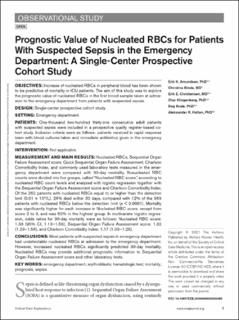| dc.contributor.author | Amundsen, Erik Koldberg | |
| dc.contributor.author | Binde, Christina | |
| dc.contributor.author | Christensen, Erik Egeland | |
| dc.contributor.author | Klingenberg, Olav Inge | |
| dc.contributor.author | Kvale, Dag | |
| dc.contributor.author | Holten, Aleksander Rygh | |
| dc.date.accessioned | 2022-05-30T07:17:59Z | |
| dc.date.available | 2022-05-30T07:17:59Z | |
| dc.date.created | 2021-11-28T22:36:47Z | |
| dc.date.issued | 2021-07 | |
| dc.identifier.citation | Critical Care Explorations. 2021, 3:e0490 (7), 1-9. | en_US |
| dc.identifier.issn | 2639-8028 | |
| dc.identifier.uri | https://hdl.handle.net/11250/2996639 | |
| dc.description.abstract | Objectives: Increase of nucleated RBCs in peripheral blood has been shown to be predictive of mortality in ICU patients. The aim of this study was to explore the prognostic value of nucleated RBCs in the first blood sample taken at admission to the emergency department from patients with suspected sepsis.
Design: Single-center prospective cohort study.
Setting: Emergency department.
Patients: One-thousand two-hundred thirty-one consecutive adult patients with suspected sepsis were included in a prospective quality register-based co-hort study. Inclusion criteria were as follows: patients received in rapid response team with blood cultures taken and immediate antibiotics given in the emergency department.
Intervention: Not applicable.
Measurement and main results: Nucleated RBCs, Sequential Organ Failure Assessment score, Quick Sequential Organ Failure Assessment, Charlson Comorbidity Index, and commonly used laboratory tests measured in the emergency department were compared with 30-day mortality. Nvaucleated RBC counts were divided into five groups, called “Nucleated RBC score,” according to nucleated RBC count levels and analyzed with logistic regression together with the Sequential Organ Failure Assessment score and Charlson Comorbidity Index. Of the 262 patients with nucleated RBCs equal to or higher than the detection limit (0.01 × 109/L), 26% died within 30 days, compared with 12% of the 969 patients with nucleated RBCs below the detection limit (p < 0.0001). Mortality was significantly higher for each increase in Nucleated RBC score, except from score 2 to 3, and was 62% in the highest group. In multivariate logistic regression, odds ratios for 30-day mortality were as follows: Nucleated RBC score: 1.33 (95% CI, 1.13–1.56), Sequential Organ Failure Assessment score: 1.32 (1.29–1.56), and Charlson Comorbidity Index: 1.17 (1.09–1.25).
Conclusions: Most patients with suspected sepsis in emergency department had undetectable nucleated RBCs at admission to the emergency department. However, increased nucleated RBCs significantly predicted 30-day mortality. Nucleated RBCs may provide additional prognostic information to Sequential Organ Failure Assessment score and other laboratory tests. | en_US |
| dc.language.iso | eng | en_US |
| dc.publisher | Lippincott, Williams & Wilkins | en_US |
| dc.relation.ispartofseries | Critical Care Explorations; | |
| dc.rights | Attribution-NonCommercial-NoDerivatives 4.0 Internasjonal | * |
| dc.rights.uri | http://creativecommons.org/licenses/by-nc-nd/4.0/deed.no | * |
| dc.subject | Emergency departments | en_US |
| dc.title | Prognostic Value of Nucleated RBCs for Patients With Suspected Sepsis in the Emergency Department: A Single-Center Prospective Cohort Study | en_US |
| dc.type | Peer reviewed | en_US |
| dc.type | Journal article | en_US |
| dc.description.version | publishedVersion | en_US |
| dc.rights.holder | © 2021 The Authors | en_US |
| dc.source.articlenumber | e0490 | en_US |
| cristin.ispublished | true | |
| cristin.fulltext | original | |
| cristin.qualitycode | 1 | |
| dc.identifier.doi | https://doi.org/10.1097/CCE.0000000000000490 | |
| dc.identifier.cristin | 1960443 | |
| dc.source.journal | Critical Care Explorations | en_US |
| dc.source.volume | 3 | en_US |
| dc.source.issue | 7 | en_US |
| dc.source.pagenumber | 1-9 | en_US |

